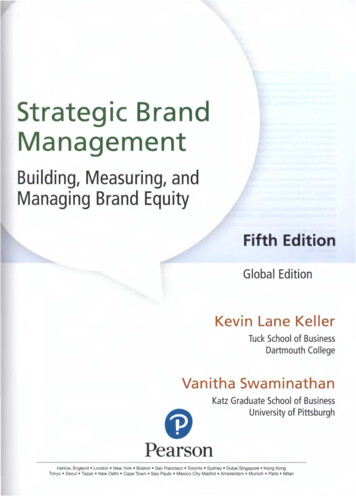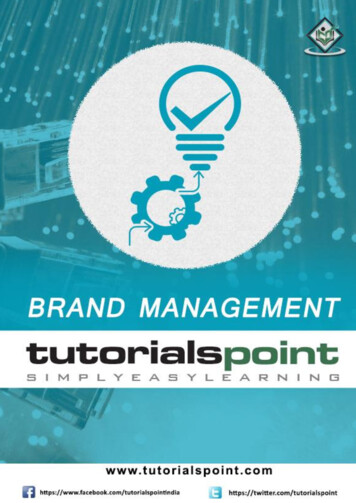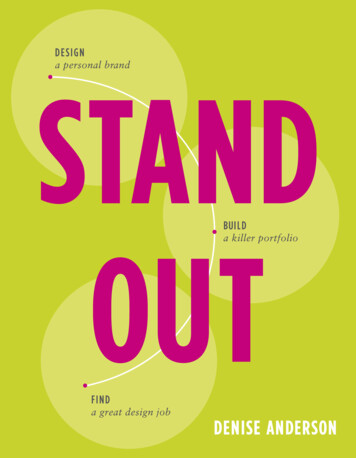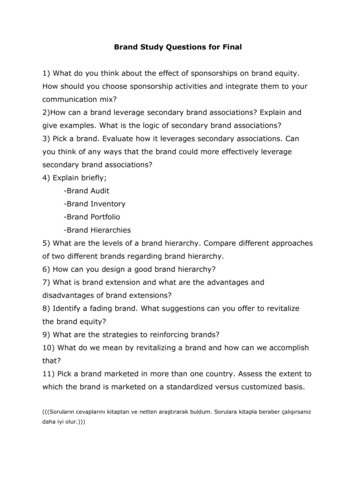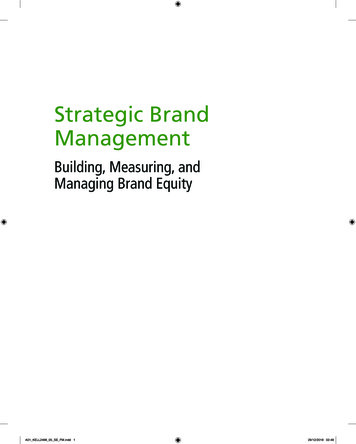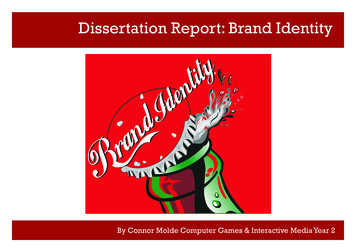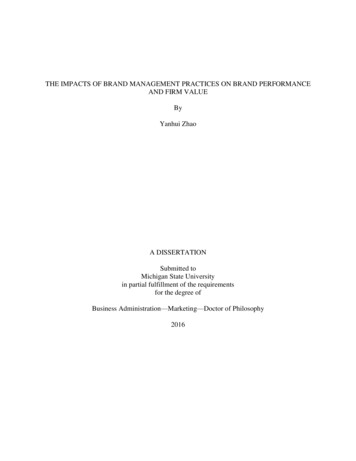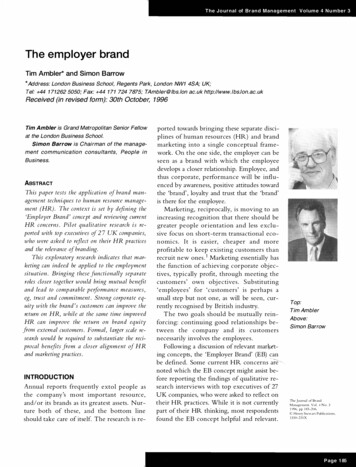
Transcription
AN INTRODUCTION TOPERSONALBRANDW O R K B O O Kwww.everywoman.com
ContentsAbout this workbook 4Section 1: 5What is personal brand and why is it so important?Section 2: 12Discovering your personal brandSection 3: 27Refining your personal brandSection 4: 33Promoting your personal brandSection 5: 38Extending your personal brandYour personal action plan 39everywoman experts 40Further reading 41Endnotes 41An introduction to personal brand2
All of us needto understandthe importanceof branding.To be in businesstoday, our mostimportant jobis to be headmarketer for thebrand called You.TOM PETERS, ‘THE BRAND CALLED YOU’, FAST COMPANYAn introduction to personal brand3
About this workbookAT EVERYWOMAN, we deliver a range of innovative products and resources that unlock thepotential and talent of women in business globally. For those women starting out or lookingto progress their careers, or build and develop their own enterprise, the everywomanNetworkprovides a wealth of personal development resources, advice and inspiration to address thechallenges faced at key stages in business.We produce workbooks on topics that matter most to our members and we’re constantlylistening to your views to give you the tools you need to propel you through your career, at atime and place that suits you.“Be authentic in your new job. Know who you are, and bring that personal brand to work.”JO RZYMOWSKA, MANAGING DIRECTOR OF CELEBRITY CRUISES UK AND IRELAND 1That’s the advice from one of our everywoman members, Jo Rzymowska. It was the mantra shelived by when she took on a big new role as Managing Director of Celebrity Cruises UK and Ireland,an internal promotion that saw her move from better-known parent company, Royal Caribbean, towhat she calls an upcoming ‘brand challenger’.She explains the mental process she went through as she prepared to make the role switch:“Although I take my job very seriously, I really like to have fun at work and it’s important to me thatI bring that quality to the office and my work with the team. Equally important is that I’m open,honest and direct. At the same time, it’s crucial, particularly as a leader, that you’re representing theorganisation, whether that’s at a networking event or on social media. That’s why it’s so importantthat you really understand the culture of the business you’re joining.”What Jo’s describing is very much an exercise in personal brand. Through undertaking it, sheunderstood what personal qualities she brings to her profession (a balance between taking workseriously with having fun, paired with openness, honesty and directness). She also understood hernew position as role model and how that might impact what she says and does both internally andpublicly. Equally, she recognised the importance of understanding how these values aligned withthose of the business.Wherever you are in your career or business journey, this workbook invites you to getstarted in this critical exercise for success. It will guide you through the practical steps ofdefining your personal brand and working out how you can promote this far and widein order to hit those key goals in your career plan.This topic requires your commitment. You need to dedicatetime to thinking about your brand and seek feedback to help you togrow in this area. It will also require having the courageto change anything that might be holding you back from makingthe most of what you have to offer. This will takeeffort and a lot of thinking as you work through the pages.The great news is that nobody knows you better than you,so you already have everything you need to get started.The everywoman teamAn introduction to personal brandTHETHINK OFS O N YO UREPSSENIBUS, AND THEERIMDAMOSTS T H ATDROWEETHRUP WILLMEHTMUSY COMELEKILTSMOB E C AU S E’STAHT.YEASILNVESTEDT H E Y ’V E INING ANDTIME DEFIG THEIRNITOMOPRB R A N D.P E R S O NA L4
Section 1What is personal brandand why is it so important?The idea of personal branding was first raised ina 1997 Fast Company magazine article by TomPeters.2 Since then, countless books, blogs andconsultancies have attempted to guide individualsthrough the process of creating a strong personalbrand to enable career success and growth. So let’sstart at the beginning. What is a personal brand?The strategic answeris that it’s the keyto leveraging the ageold rule: ‘people buypeople’. Just as companiesuse their brands to help usdecide if we want to buy theirproducts or services, you canuse your personal brand tohelp people decide whetherthey want to ‘buy’ you — asa candidate for a new roleor promotion, as a client orservice provider, as a colleague,connection or confidante.The practical answer is thatyour personal brand is aclear, concise and authenticway of communicating whoyou are, and what you’re allabout. It also tells others whatAn introduction to personal brandyou’re bringing to the tablethat other people aren’t.The fact underscoringboth these answers is thatyou already have a personalbrand — whether or notyou’ve done specific workin this area. That’s becauseyour personal brandencompasses six elementsthat define who you areand what you’re all about.While you might not feelthat you currently have adefined ‘personal brand’,you undoubtedly havevalues that determine whatmatters to you, driversthat motivate you, and areputation based on yourbehaviours, skills and image. 5
PERSONAL BRANDPersonal brand is really an umbrella term for these six E“A personal brand works much the same way as any type ofbrand. It’s a mix of factors – some tangible, some intangible –that come together to give people a feel of what you’re allabout, so they can decide if they’re going to buy into that brand.”JENNIFER HOLLOWAY,PERSONAL BRAND EXPERTAn introduction to personal brand36
The following table addresses some of the core misunderstandings aboutpersonal brand, and the expert thinking that shows its true value for your career.MYTH.Personal brandingis just aboutprojecting acertain imagethat will get youhired or promoted.WHAT THEEXPERTSSAY.EXPLORINGTHETHINKING.“Personal brand developmentis about gaining 360 feedback,developing clear, concise andconsistent messages about you,walking the walk and deliveringresults to back up the ‘talk’.”A brand or product thatdoesn’t live up to its promisewill quickly come unstuck.In the same way, whenpromoting your personalbrand, there’s no substitute formethodical groundwork andauthenticity — you’ve no doubtcome across someone whosecredibility has been impactedby their attempt to comeacross as something otherthan who they really are.IRENE MCCONNELL, MANAGINGDIRECTOR OF SYDNEY PERSONALBRANDING BOUTIQUE ARIELLECAREERSYou needextensive workexperience underyour belt beforeyou can have apersonal brand.“The truth is that you canget known and stand outas a high-end brand from dayone of launching your business[or career].”SELENA SOO, FOUNDER OF NEWYORK PERSONAL BRANDINGCONSULTANCY S2 GROUPEThere’s no needto ‘work’ on yourpersonal brand:if you’re trueto yourself inbusiness, otherswill quicklyunderstand whoyou are and whatyou’re all about.“You’ve got to know whatyou stand for and be able toarticulate your value — thebenefit that you bring to aprofessional situation — ina clear, crisp, compellingsentence. After all, if you can’tdefine what’s special aboutyourself, how can you expectothers to figure it out?”Don’t make the mistake ofthinking that your juniorposition lets you off the hook.At that point, when you’recompeting with every othernewbie in the job market,it’s more important than everthat you define and promotea strong image that otherscan relate to and buy into.Whether you’re in a jobinterview, a ‘hello’ chat withthe new department head,or meeting a potentialclient at a networking event,knowing yourself is thefirst step to authenticallypromoting yourself. CATHERINE KAPUTA, FOUNDER OFSELFBRAND.COMAn introduction to personal brand7
There’s no pointtrying to influencewhat people thinkof you — they’ll forma first impressionthat’s pretty hardto shift.Personal brandingis about shoutingabout how greatyou are from therooftops — it’s thedomain of extroverts,not shy types.“The real me isn't the personI describe, no the real me is theme revealed by my actions.”MALCOLM GLADWELL, BLINK: THEPOWER OF THINKING WITHOUTTHINKING (PENGUIN, 2005)“It’s true that many of the bestways to establish your brand inthe professional world are stillweighted toward extroverts.Yet I’m convinced it’s possibleto be real about developing[y]our personal brands, whilestill respecting [y]our naturaltendencies. First, social mediamay actually be an area whereintroverts, who thrive onquiet contemplation, have anadvantage. Introverts can alsouse subtle cues to establish theirpersonal brand.simply placingdiplomas or awards on youroffice walls can help reinforceyour expertise to others.” 4It’s true that first impressions arepowerful. Academics estimate itonly takes five seconds to makeup your mind about someone.But that’s just another reasonwhy understanding your ownpersonal brand matters — youhave to know what you’reabout in order to ensure you’reprojecting it authentically.Introvert and Harvard BusinessReview contributor, Dorie Clark,explores some of the strategiesintroverts can use to (quietly)promote their personal brands.5 KEY BENEFITSof investing time in defining a strong personal brandSome of the advantages of undertaking this workwill be unique and personal to you; others are IALITYLESS OOFINGYOURCAREER An introduction to personal brand8
Key takeaways from section 11Personal brand isn’t ‘fluff’.It’s an umbrella term for a set of six elements.2You already have a personal brand,even if you haven’t put in the work yet.3Spending some time clarifying your brandbrings a wealth of career and business-boosting benefits.4Personal brand is for everyone —new graduates benefit as much as the newly appointed CEO.NEXT:You now have a choiceIf you’re keen to get stuck straight in, you can skip to‘Refining your personal brand’ [page 27].If you’d like to explore this topic more, take the quickquiz overleaf. The aim is to help you understand whichof the six elements of personal brand you might need toinvest a little more thought into.An introduction to personal brand9
QUIZPut a tick next to each statement where you canidentify an example in your working life.I can easily complete this sentence: “It’s important to me that the place I workplaces value on ” (I)I can name five things I look for in a trusted confidante, without requiring toomuch thinking time. (I)I know what it would take for me to be proud of the organisation I work forand the people I work with. (I)I’ve a clear idea of why I’ve chosen to work in my field. (II)Thinking about the times when I’ve been at the top of my game, I know whatingredients have been in place for me to shine. (II)Aside from the obvious things – money and benefits – I have a strong sense ofwhat drives me to work and succeed in life. (II)Thinking about something I’ve done that was very successful, I’m pretty suremost people I work with are aware of the details. (III)If there were one thing I’d like my colleagues to say about me when I’m not in theoffice, I know what it would be. (III)If there was one thing I’d like a new connection to think about me after anetworking event, I know what it would be. (III)If I had to choose three adjectives to describe my personality, it wouldn’t be toohard to decide what they’d be. (IV)I’ve a good idea of what people think of me after our first meeting. (IV)When I’m faced with a new or challenging situation, I’ve a good idea how I’mgoing to react. (IV)When it comes to communicating my strengths, I can instantly rattle off threethings I’m good at, without having to think too much. (V)Some tasks come naturally to me, and my colleagues are aware of what these are. (V)If I had to choose one thing to be renowned for in my business, I know just whatit would be. (V)I have a fair idea of what new people will think of me, just from what I’m wearingor how I walk into the room. (VI)I’ve given a lot of thought to how I use my voice and my communication styles. (VI)I could talk for a while about how the way I look correlates to my working identity. (VI) An introduction to personal brand10
Each set questions (numbered I to VI) relates to a pillar of personal brand. If you’venot been able to agree with a full set of statements, pay particular attention tothat area in the following section. If you’ve a trio of ticks against a section, you’realready on your way to having clearly defined an area of your personal brand —the next section will help you consolidate that work.VALUES (I)Your moral compass.The things that matter to you which aren’t negotiable.DRIVERS (II)The things that motivate you beyond salary and benefits.REPUTATION (III)What others are saying aboutyou when you’re not in the room.BEHAVIOURS (IV)The core elements of your personalitythat make you unique.SKILLS (V)Your strengths, natural or learned.IM AG E (VI)How you present yourself to the worldAn introduction to personal brand11
Section 2Discovering yourpersonal brandNOW THAT YOU’VE discovered that yourpersonal brand consists of six elements,you’re going to work through each inturn to find what makes you unique.Eventually, you’ll whittle down what youfind into a clear, concise personal brandstatement, but before you do that you’llneed to think more broadly. Considereach section’s exercise a mini brainstorm— and don’t edit yourself; the more ideas,the better. Be yourself.Everyoneelse is takenOSCAR WILDEAn introduction to personal brand12
1VALUE SYou’re going to start with one of the trickier elements of personal brandto define: your values. It’s tricky because what constitutes a ‘value’often confuses people. Jennifer Holloway recalls how a clientdecided that ‘humour’ was one of his values.“When I asked, ‘Faced with a moral dilemma, would you everdecide, “I’m taking this decision because it’s the funny thing to do”?’he quickly realised it wasn’t a Value, but was instead a Behaviour.”5One way to determine your values is to think of them in terms of moraldilemmas and what you’d strive to do from an ethical point of viewin a particular set of circumstances. Sense check your values by puttingthem into the sentence:“It would be the [value] thing to do.”Examples of LOYALTYAUTHENTICITYCOMPASSIONCOURTESYDIGNITYMost people would say that all of the above values are important. But if youdig a little deeper, you’ll normally find that you place more stock by somethan others — often because of life experiences you’ve been shaped by. An introduction to personal brand13
VALUES EXERCISEQ: What helps you define right from wrong?Q: What would be non-negotiable about the way you or others around you act?Q: How do you feel about your company’s values? In what ways do theycomplement or contradict your own? An introduction to personal brand14
Q: Drawing on the above, list all the values that matter to you in your business life.Q: Pick out those that you can provide a tangible example for. For example,if ‘honesty’ is one of those values, indicate what honest really means to you.When have you spoken up and given your honest opinion, even if it wasn’twelcome or to do so could cause difficulties?ValueExampleContinue on a separate sheet if necessary.An introduction to personal brand15
2D R IVE R SYour drivers are the things that motivate you to go to work and dothe best job you possibly can. Salary and benefits might be the firstthings you think about, but for the purpose of this exercise, considerthe things that matter to you on a more personal or emotional level.Another way to consider what drives you is to think about whatingredients have been present when you’ve been happiest at work,and which have been absent when at your unhappiest. Some examples of driversAUTONOMYABILITYTO ST PACEDThere is often a strong link between values and drivers. For example, if youidentified ‘honesty’ as a strong value in the previous exercise, you mightfind that you’ve been most motivated at work when the culture has beenone that welcomes ‘transparency’. An introduction to personal brand16
DRIVERS EXERCISEQ: What gives you a strong sense of satisfaction or enjoyment in your work?Q: When you’ve been happiest at work, what need was being met?Q: What elements of your job do you most enjoy and why?An introduction to personal brand17
3REPUTATIONYou might not be able to control what it is people are sayingabout you when you’re not in the room, but you do have a lotof influence over it. That’s why ‘reputation’ is one of the sixpillars of personal brand.You probably already have a strong sense of what you’d like yourreputation to be. Defining it in clear terms, and working hard toensure the message comes across loud and clear, is the next step. Examples of reputationSHE/HE.ALWAYSDOES WHATTHEY SAYTHEY’LL DOTELLS ITLIKE IT ISIS THECALMESTPERSON INA CRISISLEAVESNO STONEUNTURNEDDOESN'TSTANDFOR ANYNONSENSEIS FULLOF GOODIDEASIS A TEAMPL AYERPULLS OUTALL THESTOPSIS A REALMAVERICK“Your personal brand is what people sayabout you when you’re not in the room.”JEFF BEZOS, FOUNDER OF AMAZONAn introduction to personal brand18
REPUTATION EXERCISEQ: Think of a person who knows you well in business. If someone calledthem up and asked them to highlight one thing about you, what would it be?Q: Imagine your boss and your boss’s boss are having a conversation about you.What would you love for them to be saying?Q: Imagine a relative newcomer to the business (someone who’s yet to reallyget to know you) calls up and asks for your help. What’s it likely to be about?An introduction to personal brand19
4BEHAVIOURSBehaviours are usually adjectives that bestdescribe who you are. They are often theproduct of some of the other pillars. Forexample, if you value honesty above all else,this might come out in your behaviours asfrankness or openness. Or if you’re stronglydriven by a desire to help, you might seeyourself and be seen as a real people person. Examples of HTFULSERIOUSRESILIENTPURPOSEFULDOWNTO-EARTHAn introduction to personal brand20
BEHAVIOURS EXERCISEQ: What words would you use to describe your personality at work?Q: How do you act around others?Q: If you had to sum yourself up in three words, what would they be?Give an example of how each behaviour has manifested in your workplace?123An introduction to personal brand21
5SKIL LSWhen considering your skillset, ask yourself ifthat item on your list is truly a skill or is actuallyan outcome of using your skill. For example,you might consider ‘organisation’ a skill, but it’smore likely to be an outcome of using your realskill, which might be process management orlist-making. Being as specific as possible helpsmakes your personal brand more unique. Examples of SRUNNINGMEETINGSIDENTIFYINGCOST SAVINGSAn introduction to personal brand22
SKILLS EXERCISEQ: What tasks do you perform effortlessly, that others might struggle with?Q: What elements do you perform as part of your role that give you the biggestconfidence boost or elicit the best feedback?Q: What do colleagues come to you for help with?An introduction to personal brand23
6IMAGEA good way to think about image is how you present yourvalues, drivers, skills, behaviours and reputation to the worldaround you. It’s not about pretending to be something you’renot; rather it’s about ensuring that how others perceive you isan authentic match with your sense of self.Examples of imageC L AS S ICTREN DYSHA RPTA IL OR E DL O UDL AID B ACKNAT U R A LCOO RD IN ATEDUN D ERSTATEDPeople often make the mistake of thinking that imageis all about how you look. Your clothes, accessories,body language and eye contact do inevitably playa huge role in your image. Also important is:How you sound (your accent, tone, volume, choiceof words)l How you act (how your behaviours come throughand appear to others)l Your online presence (the image and words youuse on your LinkedIn profile)lThe most authentic images are natural extensions ofeach of the six components of personal brand. JenniferHolloway explains how each of these components joinsup with her image. An introduction to personal brand“When I worked on my own brandand concluded being sassy, savvyand sure were key components, Imade certain my image reflectedthat. As a result, how I look alwaysincludes my trademark red lipstickand nail polish. How I soundis chatty with a lot of humourthrown in (also reflected in how Iwrite). And how I act is confidentbut still down-to-earth.”JENNIFER HOLLOWAY624
IMAGE EXERCISEQ: What words would you use to describe how you look?Q: How would you describe your voice and communication style?Q: What would people learn about you just from seeing or hearing you?An introduction to personal brand25
Key takeaways from section 21Your values are those things that matter to you aboveall else — faced with a moral dilemma, they dictate howyou’d behave and what you expect of others.2Your drivers are those things that motivate you to keepturning up to work and using your talents.3Your behaviours are the core aspects of yourpersonality that make you ‘you’.4Your skills are those things you’re reallygood at, that get you noticed.5Your reputation is what people say aboutyou when you’re not in the room.6Your image is a blend of how each of the abovecomponents is conveyed.7The more specific you can be about each of these components,the more clearly defined your personal brand is likely to be.NEXT:You’ve brainstormed around each of the six pillars. Now it’stime to focus in on what truly matters in terms of whatyou communicate to others. In the next section, ‘Refining yourpersonal brand’, you’ll ‘stress test’ the ideas you’ve alreadycome up with to hone in on what truly makes you ‘you’. An introduction to personal brand26
Section 3Refining your personal brandTHE WORK YOU’VE done in the previoussection gives you a wealth of data andideas to draw on. In this section, you’llwork on paring down all that informationand crafting it into a strong, clear andconcise personal brand message. You’regoing to begin by reflecting on what you’vealready worked up. Look back at eachexercise and ask yourself the following:1IS IT MORETHAN PEOPLEWOULD EXPECT?There’s no point sellingpeople what they’realready expecting,so don’t say you’re“professional” or “friendly”or “approachable”.A designer needn’tsay they’re “creative”and an accountantneedn’t say they’re“good with numbers”.2IS IT A REALSTRENGTH?If your brand is aboutstanding out fromthe crowd, lookfor the things youknow you have inspades that you canhonestly say, “I’m great at”,not just the thingsthat you think you’dlike in your brandbut could only say,“I’m fairly good at”.3IS IT SPECIFICENOUGH?The more exact youcan be about whatit is you offer, thebetter chance you haveof your individualityshining through.Once you’ve chosen the best two or three ingredients in each of the brand elements,you need to craft a sentence that pulls them all together. See an example over the page.An introduction to personal brand27
EXAMPLE STATEMENTSVALUESI respect others and am always truthful — I believe honesty can get you far.DRIVERSI'm motivated by being my own person, even if that's out of step with everyone else.REPUTATIONI'm known for delivering under pressure —often with an 'added extra' that wasn't even asked for.BEHAVIOURSMy personality is calm and composed with an underlying drive and focus.SKILLSI enjoy solving problems and relish the challenge of thinkingdifferently to create an unexpected solution.IMAGEMy creative thinking is reflected in my dress sense,giving me a unique look that shows I like to be individual.EXERCISEYOUR MAGEAn introduction to personal brand28
PUTTING IT TO THE TESTYour brand exists in two places: yourown head and everybody else’s head.Up to now you’ve mostly been consideringyour personal brand from your ownstandpoint. Now it’s time to considerwhether the ‘you’ you’ve identified inyour six core statements measures upwith the brand image others hold of you.Many peopleassume firstimpressionshappen whenthey meet someone inperson, but the clock actuallystarts ticking before then— hearing your voicemail,receiving your email, seeingyou give a presentation,watching you drive up inyour car, even hearing yourringtone down the corridor.If you’re serious aboutdeveloping your personalbrand, getting directfeedback is crucial. FeelingAn introduction to personal brandnervous about asking peoplewhat they think of you isperfectly natural; even themost seasoned professionalwill have reservations aboutwhat they’ll discover. However,finding out all the positivethings people associatewith you will do wondersfor your confidence. Shouldanything untoward come tolight, it’s better to be awareof it so you can do somethingabout it. By undertaking thefollowing exercise, you’ll becreating a feedback plan tostress test the personal brandyou’ve devised. 29
EXERCISE1. Whose opinions do you trust? In drawing up your list, try to get a goodmix of people who’ve known you for years and others you’ve worked withfor just a short while. Try to get a broad mix, too, of strong supporters andindividuals you haven’t always necessarily seen eye-to-eye with.RECIPIENTSBEST CHANNEL FORREQUESTING FEEDBACK,e.g., email, invite for coffeeto discuss, phone call etc.123456789101112An introduction to personal brand30
2. What questions can you ask to best draw out their thoughts on the personalbrand you’ve devised, based on the six pillars? It’s best to keep questions open(as opposed to closed questions, which usually elicit a “yes” or “no” reply).Open questions begin with words such as: what, why, how, describe.e.g., What could I do more or less of, or stopor start, to improve my personal brand?12345678910An introduction to personal brand31
TOP TIPS1. PERSONALISEIf you’re requesting feedback by email, personaliseyour message as much as possible.2. HONESTYAssure those you’re requesting feedback fromthat their responses will be taken with an openmind and that their honesty is appreciated.3. TIMEGive an indication of how long you think it willtake them to answer the questions, when you’dideally like answers by and why their opinion isso important to you.4. INCORPORATEWhen you collate the feedback, look for waysthat the comments support your own perceptionof your personal brand, but also any positivecomments that throw up elements of yourpersonal brand that you’re overlooking andwhich you should incorporate.Key takeawaysfrom section 35. CRITICISMDon’t ignore the negatives. Reflect on anyconstructive criticism before asking for clarity orexamples, if necessary. If any feedback contradictsyour own idea of your personal brand, wait untilany emotions have subsided before consideringaction. Is this simply a difference of opinion, orsomething you need to address?6. RETURNWhether it’s positive or negative, give thefeedback an initial read then put it to one sideand don’t look at it again for 24 hours. You’ll spotdifferent things than you did the first time andthe added perspective could mean you get morefrom the answers.1Defining your personal brand shouldn’tbe done in isolation — gather as manyopinions and as much feedback aspossible to help steer your thinking.2Accept all feedback graciously, andsleep on it for a while before you makeany decisions about how the comments,whether positive or negative, shouldaffect your personal brand.NEXT:You’ve devised a personal brand and gathered feedback to ensure you’re on the right track.Now it’s time to start broadcasting your message in line with a career goal.An introduction to personal brand32
Section 4Promoting yourpersonal brandA personal brand works in exactly the sameway as a company or product brand: youhave to advertise, market and promote it toget it noticed. That’s why it’s a good idea toset out a marketing plan to keep yourselffocused on the task at hand and make sureyou’re maximising every opportunity.To make this exercise asvaluable as possible for youand your career plan, you’regoing to draft a marketingplan based on a particular goal youwant to achieve in the short, mediumor long term. It could be getting apromotion, winning a new client orproject, becoming more efficient at aparticular routine task, getting morebuy-in from your boss or team as awhole or even taking a change ofdirection or complete career change. An introduction to personal brand33
EXERCISE1. With your goal in mind, decide on your three key audiences. They’re the peoplewho, if they were saying great things about your personal brand when youweren’t in the room, could really boost your profile and the opportunities thatcome your way. Your target audiences might be individual people — for example,your boss, if you’re looking for a promotion, or groups, which could includepotential customers who you need to grow your business. They might also bepeople who aren’t immediately obvious — for example, your boss’s PA, whoseopinion they value, or a high-profile blogger who writes about your sector.KEY AUDIENCE 1KEY AUDIENCE 2KEY AUDIENCE 32. What are their key motivators? In other words, what matters to themand what aspect of your personal brand best appeals to these motivators?AUDIENCEMOTIVATORBRAND APPEAL123An
An introduction to personal brand 4 That’s the advice from one of our everywoman members, Jo Rzymowska. It was the mantra she lived by when she took on a big new role
